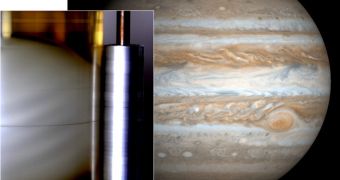The appearance of gas giants has puzzled scientists ever since the first clear photos of their surface became available. This is especially true in the case of Saturn and Jupiter, both of which feature prominent stripes. Researchers now believe they may have just discovered one of the mechanisms that might have led to the stripes developing in the first place. The idea was tested in a simple, laboratory-based setting, which in the end yielded new insights into how the stripes of Jupiter appeared.
The massive planet has in excess of 60 discovered moons, all of which exert their influence on its surface. While this may seem insignificant at first, due to the fact that some of these bodies are very small, their combined effects are enough to cause quite a stir. The results are tides, similar to the ones the Moon's motions cause in our own planet's oceans. Physicists now believe that these tides may play at least some role in the overall development of the planetary stripes. Naturally, other factors are at work as well, the team behind the investigation admits, as evidence by the study results themselves.
The stripe-like patterns on Jupiter are produced by phenomena known as zonal winds. These atmospheric motions travel at different speeds, thus producing the patterned appearance. But determining what produces these winds, and where they come from, has been a long-standing puzzle in astronomy. ““Even after 40 years, it’s still an active subject,” explains University of Washington in Seattle oceanographer Peter Rhines. Some proposed that a physical phenomenon called convection might have something to do with them, but German experts at the University of Gottingen, and scientists from the Aix-Marseille University's National Center for Scientific Research (CNRS), in France, disagree.
UG geophysicist Andreas Tilgner believes that convection has nothing to do with it. He and his collaborators demonstrated this by devising a simple lab experiment. The team took a cylinder of stretchy silicon, and then created a spherical void within, which they filled with water. Asymmetrical plastic flakes were then inserted in the water, so as to mimic the behavior of gas within Jupiter. The cylinder was then placed between two rollers, to simulate the tidal effects of the planet's moons. Depending on how fast the “planet” and the rollers spun, various patterns appeared on the surface, including some very similar to the ones on the planet, ScienceNow reports.

 14 DAY TRIAL //
14 DAY TRIAL //